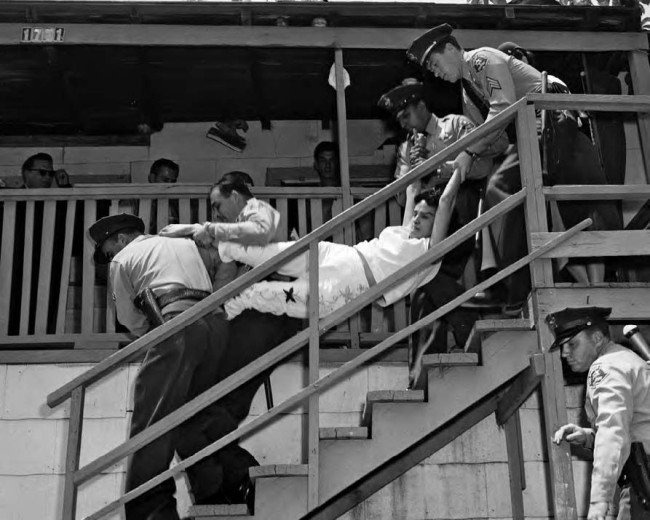Stealing Home: Eminent Domain, Urban Renewal, and the Loss of Community
Lesson by Linda Christensen
Aurora Vargas is carried by Los Angeles County Sheriff’s deputies after her family refused to leave their house in Chávez Ravine. May 8, 1959. Source: Hugh Amott, Los Angeles Times.
Desiree Barksdale’s description [below] reveals the pain that many students feel when their home is stolen — through eviction, divorce, court orders that place them in foster care, or gentrification that pushes low-income and people of color out of our school’s neighborhood and into the “numbers,” as the students call the outer ring of Portland where they have landed.
I knew it was the eviction notice that came no matter how hard [my mother] worked, how good we were, how friendly of a neighbor we were. I was young, but I wasn’t stupid. I knew we were going to have to move again, but so soon this time? Would we end up in a shelter again? Would we have to switch schools? Again? Tears swelled my eyes and poured down my dirty, 8-year-old cheeks. My tiny fists clenched so tight my knuckles turned white, my whole body shook with angry sobs. Barely brushing 4 feet tall, I was going to destroy the whole world for what they were doing to me: for taking away my security, my happiness, my home.
After hearing students like Desiree discuss the gentrification of Jefferson High School’s neighborhood, Dianne Leahy, the insightful and hardworking teacher with whom I co-taught junior English for the last two years, and I decided to create a yearlong curriculum we christened “Stealing Home.” In the unit, we look at the history and literature of stolen homes and land — from Native American “removals” to reservations, to the violent expulsions of African Americans during the 1920s and ’30s, to the internment of Japanese Americans during World War II. We look at the resistance that emerged. The last segment of our unit — eminent domain and urban renewal — brings the teaching back to our neighborhood and the students’ anger over gentrification that initiated our investigation.
To understand how eminent domain works, students consider Chávez Ravine, where Dodger Stadium now lives, and Albina, the historic African American neighborhood that Jefferson High School anchors.
Chavez ravine evictions, 1959.
We started with Hugh Arnott’s photograph of Chávez resident Aurora Vargas, being physically carried from her home by police officers. As we showed students the Vargas slide, we said, “First, just notice what you see. Make a list of your observations about the photograph.” As students shared their observations, we listed them on the board. For the next section, we asked students to make connections. “What does this photograph remind you of? Anything from your life? From movies? From a book?” Again students shared out loud.
As a language arts teacher, I have a duty to teach students to read and write effectively, but one cannot write without learning how to think about the world, to step back from our individual pain and ask questions and find patterns. I want students like Desi to know that her loss of home wasn’t because she wasn’t good enough or smart enough, but because we live in a system that continues to put profit over people.


